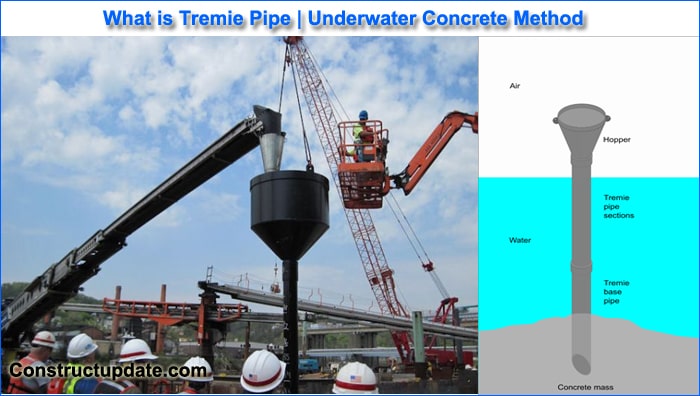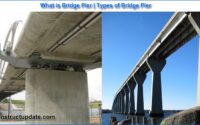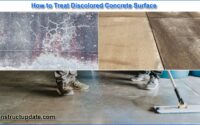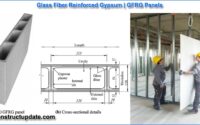What is Tremie Pipe | Underwater Concrete Methods
What Is a Tremie Pipe?
A tremie pipe is a concrete placement system that is utilised underwater. Piling works, basements, diaphragm walls, caissons, submarine foundations, and other structures use it extensively.
The diameter of a tremie pipe ranges from 20 to 30 cm and is constructed of plastic tubes or stiff metal material.
The concrete is carried through the water in a watertight box or bucket in the bottom-dump bucket, and when it reaches the final deposition location, the bottom bucket mechanism opens automatically, and the entire concrete is dropped slowly.
This procedure will not produce adequate results since a certain amount of cement will be washed away.
A dry or semi-dry mixture of cement, fine and coarse aggregate is loaded in cement bags and deposited on the bed below the water in various instances.
Underwater Concrete Methods
Following are the methods of underwater concreting:
The tremie method of underwater concreting is ideal for draining large amounts of heavy leaky concrete.
Further pumps and belt skips move the concrete to the hopper.
Tremie pipe is used to locate concrete from the hopper at the field, with the top end joined to a hoper and the bottom end running submerged in new concrete.
The purpose of dipping the tremie pipe’s bottom end is to prevent the mixing of concrete and water.
Tremie pipe should have a large enough diameter to prevent leaks due to its mass.
The most common diameter for up and downsize is 200-300mm aggregate of a transparent junction.
A plug secures the lower end, which is chosen below.
At the spot where the concrete is running, the water keeps the peace. The end is approaching, and no water will have flowed through the pipe.
When the complete size of the tube is covered with concrete, the tremie pipe boost, and a tiny jolt produced by a tackle and pulley, the concrete must have a 15-20cm slump to dig into the funnel.
The lower plug collapses due to a load of concrete when the line heaves and provides a draw, and concrete is released.
This circumstance requires special attention in order to determine the outcome.
Tremie pipe continues in concrete, preventing water from entering the line from below.
The tube is slightly boosted and given a minor shock once more after the concrete is dug over the funnel and the complete size of the tremie pipe is covered with concrete.
Make every effort to keep the tremie pipe’s bottom end in raised concrete. During that time, the concrete in the tremie pipe is released.
The concrete is not affected by the water omitting the higher end as a result of this procedure running smoothly.
At the end of the function, the upper layer is filtered to remove the damaged concrete.

Tremie Pipe Concreting Key Features
Pumping of water should not be permitted throughout the concreting process. if water is pumped at the same time as cement particles Underwater concreting does not require compacting because the hydrostatic pressure of water compacts the concrete mechanically.
Second, because the concrete is so consistent, it rarely needs to be compacted.
One of the disadvantages of this method of underwater concreting is that a high water/cement ratio is necessary for high consistency, lowering concrete strength. However, with the application of superplasticizer, this is no longer an issue. A concrete with as low as a w/c ratio as 0.3 or even less can be put via the tremie method.
The grouting of pre-packed aggregate is another method for placing concrete underneath water that is less typically used. The coarse aggregate is dumped to fill the concrete mass completely.
The prepared cement mortar grout is injected into the aggregate bed through a pipe that runs to the bottom. As the grouting advances, the pipes are gradually withdrawn.
The grout pushes the water out of the cracks and takes up the area. This procedure is frequently used for good foundation plugging.
Pipes and concrete pumps can also be used to put concrete underwater. At one end, the pipeline is plugged and lowered till it reaches the bottom. The pumping process then begins.
The plug is driven out after the pipe is entirely filled; the concrete covering the pipe’s bottom end seals it.
Pumping is done against the lower end of the plug’s pressure. The pipe is withdrawn and the operation is repeated when the pumping effort necessary to overcome the pressure is too large. This procedure is repeated until the concrete reaches the top of the water level.





